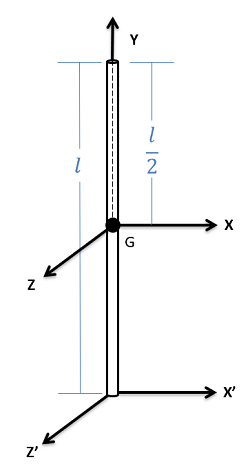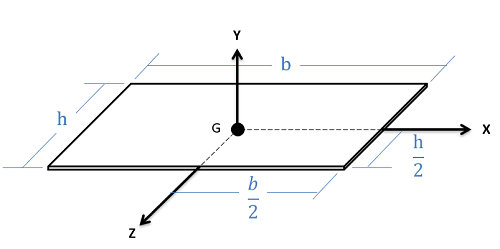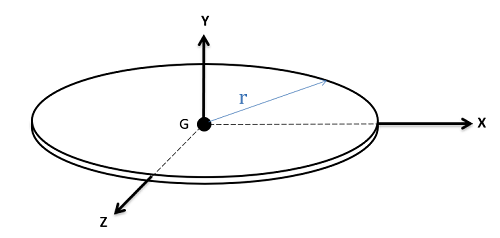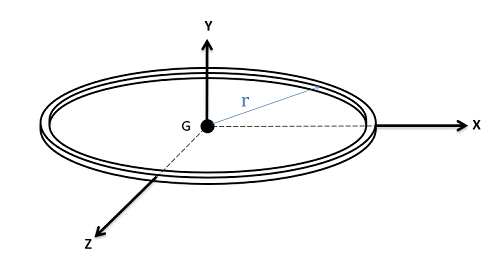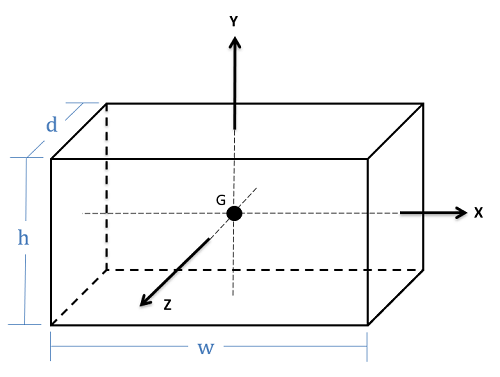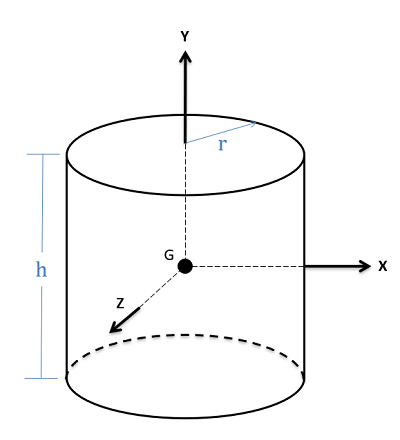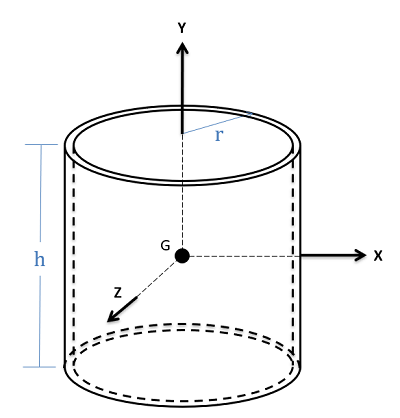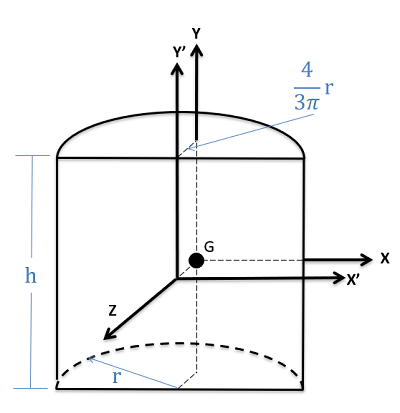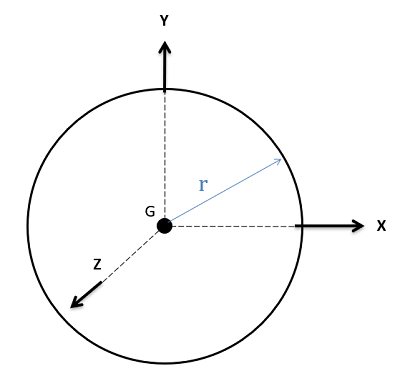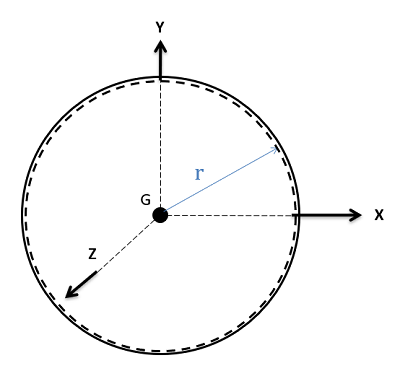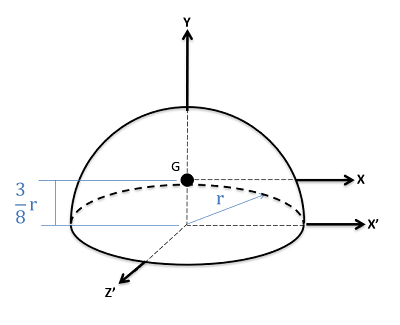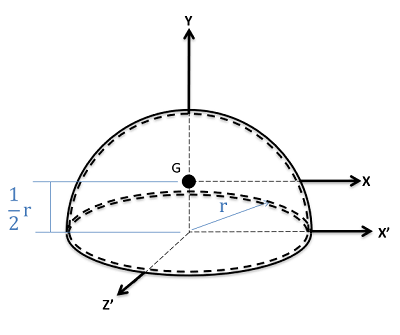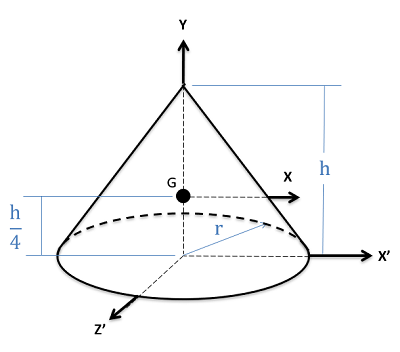Center of Mass and Mass Moments of Inertia for Homogeneous 3D Bodies
- Page ID
- 58319
\( \newcommand{\vecs}[1]{\overset { \scriptstyle \rightharpoonup} {\mathbf{#1}} } \)
\( \newcommand{\vecd}[1]{\overset{-\!-\!\rightharpoonup}{\vphantom{a}\smash {#1}}} \)
\( \newcommand{\dsum}{\displaystyle\sum\limits} \)
\( \newcommand{\dint}{\displaystyle\int\limits} \)
\( \newcommand{\dlim}{\displaystyle\lim\limits} \)
\( \newcommand{\id}{\mathrm{id}}\) \( \newcommand{\Span}{\mathrm{span}}\)
( \newcommand{\kernel}{\mathrm{null}\,}\) \( \newcommand{\range}{\mathrm{range}\,}\)
\( \newcommand{\RealPart}{\mathrm{Re}}\) \( \newcommand{\ImaginaryPart}{\mathrm{Im}}\)
\( \newcommand{\Argument}{\mathrm{Arg}}\) \( \newcommand{\norm}[1]{\| #1 \|}\)
\( \newcommand{\inner}[2]{\langle #1, #2 \rangle}\)
\( \newcommand{\Span}{\mathrm{span}}\)
\( \newcommand{\id}{\mathrm{id}}\)
\( \newcommand{\Span}{\mathrm{span}}\)
\( \newcommand{\kernel}{\mathrm{null}\,}\)
\( \newcommand{\range}{\mathrm{range}\,}\)
\( \newcommand{\RealPart}{\mathrm{Re}}\)
\( \newcommand{\ImaginaryPart}{\mathrm{Im}}\)
\( \newcommand{\Argument}{\mathrm{Arg}}\)
\( \newcommand{\norm}[1]{\| #1 \|}\)
\( \newcommand{\inner}[2]{\langle #1, #2 \rangle}\)
\( \newcommand{\Span}{\mathrm{span}}\) \( \newcommand{\AA}{\unicode[.8,0]{x212B}}\)
\( \newcommand{\vectorA}[1]{\vec{#1}} % arrow\)
\( \newcommand{\vectorAt}[1]{\vec{\text{#1}}} % arrow\)
\( \newcommand{\vectorB}[1]{\overset { \scriptstyle \rightharpoonup} {\mathbf{#1}} } \)
\( \newcommand{\vectorC}[1]{\textbf{#1}} \)
\( \newcommand{\vectorD}[1]{\overrightarrow{#1}} \)
\( \newcommand{\vectorDt}[1]{\overrightarrow{\text{#1}}} \)
\( \newcommand{\vectE}[1]{\overset{-\!-\!\rightharpoonup}{\vphantom{a}\smash{\mathbf {#1}}}} \)
\( \newcommand{\vecs}[1]{\overset { \scriptstyle \rightharpoonup} {\mathbf{#1}} } \)
\( \newcommand{\vecd}[1]{\overset{-\!-\!\rightharpoonup}{\vphantom{a}\smash {#1}}} \)
\(\newcommand{\avec}{\mathbf a}\) \(\newcommand{\bvec}{\mathbf b}\) \(\newcommand{\cvec}{\mathbf c}\) \(\newcommand{\dvec}{\mathbf d}\) \(\newcommand{\dtil}{\widetilde{\mathbf d}}\) \(\newcommand{\evec}{\mathbf e}\) \(\newcommand{\fvec}{\mathbf f}\) \(\newcommand{\nvec}{\mathbf n}\) \(\newcommand{\pvec}{\mathbf p}\) \(\newcommand{\qvec}{\mathbf q}\) \(\newcommand{\svec}{\mathbf s}\) \(\newcommand{\tvec}{\mathbf t}\) \(\newcommand{\uvec}{\mathbf u}\) \(\newcommand{\vvec}{\mathbf v}\) \(\newcommand{\wvec}{\mathbf w}\) \(\newcommand{\xvec}{\mathbf x}\) \(\newcommand{\yvec}{\mathbf y}\) \(\newcommand{\zvec}{\mathbf z}\) \(\newcommand{\rvec}{\mathbf r}\) \(\newcommand{\mvec}{\mathbf m}\) \(\newcommand{\zerovec}{\mathbf 0}\) \(\newcommand{\onevec}{\mathbf 1}\) \(\newcommand{\real}{\mathbb R}\) \(\newcommand{\twovec}[2]{\left[\begin{array}{r}#1 \\ #2 \end{array}\right]}\) \(\newcommand{\ctwovec}[2]{\left[\begin{array}{c}#1 \\ #2 \end{array}\right]}\) \(\newcommand{\threevec}[3]{\left[\begin{array}{r}#1 \\ #2 \\ #3 \end{array}\right]}\) \(\newcommand{\cthreevec}[3]{\left[\begin{array}{c}#1 \\ #2 \\ #3 \end{array}\right]}\) \(\newcommand{\fourvec}[4]{\left[\begin{array}{r}#1 \\ #2 \\ #3 \\ #4 \end{array}\right]}\) \(\newcommand{\cfourvec}[4]{\left[\begin{array}{c}#1 \\ #2 \\ #3 \\ #4 \end{array}\right]}\) \(\newcommand{\fivevec}[5]{\left[\begin{array}{r}#1 \\ #2 \\ #3 \\ #4 \\ #5 \\ \end{array}\right]}\) \(\newcommand{\cfivevec}[5]{\left[\begin{array}{c}#1 \\ #2 \\ #3 \\ #4 \\ #5 \\ \end{array}\right]}\) \(\newcommand{\mattwo}[4]{\left[\begin{array}{rr}#1 \amp #2 \\ #3 \amp #4 \\ \end{array}\right]}\) \(\newcommand{\laspan}[1]{\text{Span}\{#1\}}\) \(\newcommand{\bcal}{\cal B}\) \(\newcommand{\ccal}{\cal C}\) \(\newcommand{\scal}{\cal S}\) \(\newcommand{\wcal}{\cal W}\) \(\newcommand{\ecal}{\cal E}\) \(\newcommand{\coords}[2]{\left\{#1\right\}_{#2}}\) \(\newcommand{\gray}[1]{\color{gray}{#1}}\) \(\newcommand{\lgray}[1]{\color{lightgray}{#1}}\) \(\newcommand{\rank}{\operatorname{rank}}\) \(\newcommand{\row}{\text{Row}}\) \(\newcommand{\col}{\text{Col}}\) \(\renewcommand{\row}{\text{Row}}\) \(\newcommand{\nul}{\text{Nul}}\) \(\newcommand{\var}{\text{Var}}\) \(\newcommand{\corr}{\text{corr}}\) \(\newcommand{\len}[1]{\left|#1\right|}\) \(\newcommand{\bbar}{\overline{\bvec}}\) \(\newcommand{\bhat}{\widehat{\bvec}}\) \(\newcommand{\bperp}{\bvec^\perp}\) \(\newcommand{\xhat}{\widehat{\xvec}}\) \(\newcommand{\vhat}{\widehat{\vvec}}\) \(\newcommand{\uhat}{\widehat{\uvec}}\) \(\newcommand{\what}{\widehat{\wvec}}\) \(\newcommand{\Sighat}{\widehat{\Sigma}}\) \(\newcommand{\lt}{<}\) \(\newcommand{\gt}{>}\) \(\newcommand{\amp}{&}\) \(\definecolor{fillinmathshade}{gray}{0.9}\)| Shape with Volume and Center of Mass Location Shown | Mass Moments of Inertia |
|---|---|
|
Slender Rod
|
\(I_{xx} = I_{zz} = \dfrac{1}{12} ml^2\) \(I_{yy} = 0\) \(I_{xx'} = I_{zz'} = \dfrac{1}{3} ml^2\) |
|
Flat Rectangular Plate
|
\(I_{xx} = \dfrac{1}{12} mh^2\) \(I_{yy} = \dfrac{1}{12} m (h^2 + b^2) \) \(I_{zz} = \dfrac{1}{12} mb^2\) |
|
Flat Circular Plate
|
\(I_{xx} = I_{zz} = \dfrac{1}{4} mr^2\) \(I_{yy} = \dfrac{1}{2} mr^2\) |
|
Thin Circular Ring
|
\(I_{xx} = I_{zz} = \dfrac{1}{2} mr^2\) \(I_{yy} = mr^2\) |
|
Rectangular Prism
\(Volume = dwh\) |
\begin{align*} I_{xx} &= \frac{1}{12} m(h^2 + d^2) \\[4pt] I_{yy} &= \frac{1}{12} m(d^2 + w^2) \\[4pt] I_{zz} &= \frac{1}{12} m(h^2 + w^2) \end{align*} |
|
Cylinder
\(Volume = \pi r^2 h\) |
\( I_{xx} = I_{zz} = \dfrac{1}{12} m(3r^2 + h^2) \) \(I_{yy} = \dfrac{1}{2} mr^2\) |
|
Thin Cylindrical Shell
|
\(I_{xx} = I_{zz} = \dfrac{1}{6} m(3r^2 + h^2)\) \(I_{yy} = mr^2\) |
|
Half Cylinder
\(Volume = \dfrac{1}{2} \pi r^2h\) |
\(I_{xx} = I_{zz} = \left( \dfrac{1}{4} - \dfrac{16}{9 \pi^2} \right) mr^2 + \dfrac{1}{12} mh^2\) \(I_{yy} = \left( \dfrac{1}{2} - \dfrac{16}{9 \pi^2} \right) mr^2\) \(I_{xx'} = I_{zz'} = \dfrac{1}{12} m(3r^2 + h^2)\) \(I_{yy'} = \dfrac{1}{2} mr^2\) |
|
Sphere
\(Volume = \dfrac{4}{3} \pi r^3\) |
\(I_{xx} = I_{yy} = I_{zz} = \dfrac{2}{5} mr^2\) |
|
Spherical Shell
|
\(I_{xx} = I_{yy} = I_{zz} = \dfrac{2}{3} m r^2\) |
|
Hemisphere
\(Volume = \dfrac{2}{3} \pi r^3\) |
\(I_{xx} = I_{zz} = \dfrac{83}{320} mr^2\) \(I_{yy} = \dfrac{2}{5} mr^2\) \(I_{xx'} = I_{zz'} = \dfrac{2}{5} mr^2\) |
|
Hemispherical Shell
|
\(I_{xx} = I_{zz} = \dfrac{5}{12} mr^2\) \(I_{yy} = \dfrac{2}{3} mr^2\) \(I_{xx'} = I_{zz'} = \dfrac{2}{3} mr^2\) |
|
Right Circular Cone
\(Volume = \dfrac{1}{3} \pi r^2 h\) |
\(I_{xx} = I_{zz} = \dfrac{3}{80} m(4r^2 + h^2) \) \(I_{yy} = \dfrac{3}{10} mr^2\) \(I_{xx'} = I_{zz'} = \dfrac{1}{20} m(3r^2 + 2h^2) \) |


